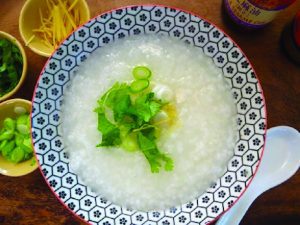By Toni Eatros, MS, Dipl Ac, AP
 Every day in my clinic, I see people with a wide variety of chronic illness. Regardless, of the type of illness, all of these people have one thing in common, they are deficient in Qi and sometimes Blood. What does deficient mean? Deficient means that there is not enough raw material to make the body systems work properly. These people usually have a very weak pulse and a pale and puffy face and tongue.
Every day in my clinic, I see people with a wide variety of chronic illness. Regardless, of the type of illness, all of these people have one thing in common, they are deficient in Qi and sometimes Blood. What does deficient mean? Deficient means that there is not enough raw material to make the body systems work properly. These people usually have a very weak pulse and a pale and puffy face and tongue.
Qi is your body’s innate energy that makes everything happen in the body. When the body does not have enough Qi, the organs and cells cannot optimally perform their functions and illness begins. It makes sense, then, to work on boosting Qi in the body when there is chronic illness. When the Qi energy increases, the body will begin to work more efficiently and healing will ensue. We do not need to banish the illness, we can work on the basics of tonifying Qi and nourishing the blood. The body has the amazing capability to heal when given the appropriate building blocks.
For the purpose of this article, we are going to focus on tonifying, or building Qi. Look for my article next month that discusses nourishing Blood. In traditional Chinese medicine, the Stomach and Spleen are said to be responsible for the digestive process. We build Qi in our bodies through eating, digesting, and absorbing the quality nutrients from our food and from the air we breathe. In order for this to happen, we need to have a strong functioning Stomach and Spleen. Now the Spleen in TCM is different from how the medical doctors in the west view the Spleen. In TCM, the Spleen and Stomach are the first and most pivotal organs in the creation of Qi and Blood from food and beverages that we consume.
The Stomach can be likened to a soup kettle on the stove. The Spleen, then, is the fire under the kettle. The goal in digestion is to transform the food we eat into a 100 degree soup where the food is broken down. If you do not have an adequate amount of Qi, then the Spleen will not have the ability to turn up the fire under the kettle and cook the food. If the food in the Stomach does not reach 100 degrees, no further digestion can take place.
“The hundreds of diseases of the four seasons all originate in the stomach….Therefore, if the diet is improved one inch, the disease pathogen is forced back one inch.”
—- Jin Zi-jiu
Taking this metaphor one step further, it is easy to understand why eating cold and raw foods and iced beverages make them less digestible. Cooking begins the digestive process, reducing the work the Spleen has to do. It is recommended that all food and beverages eaten are at room temperature for the easiest and most complete digestion. Chewing food thoroughly also aids the digestive process.
When the Spleen works well, the clear, pure essence is separated from the food and sent upward to the Lungs and Heart to become Qi and Blood. The waste material is separated and sent downward to be excreted from the body. When digestion is not functioning optimally, this separation does not occur and the waste as well as the pure, clear essence goes downward, resulting in loose stools and the inability to build Qi and Blood.
One of the easiest and best ways to build Qi is to eat Congee. Congee is called shi fan, water rice, in Mandarin and jook in Cantonese. It is a dilute porridge, gruel or soup made mostly with water and rice, however, other combinations of grains, beans, vegetables, and meat can be used.
The wonderful thing is congee is so easy to make. Ideally you would start your day by eating congee.
The night before, add the rice, water, and any other grains, beans or herbs you want. Turn the crock pot on low and simmer over night. In the morning, breakfast is ready. Just spoon out the congee, add your selection of vegetables, meats or eggs, season and enjoy feeling satisfied, light and energetic.
Medicinal congees are made by adding Chinese herbs and various grains and beans to the congee. Some herbs, like Chinese red dates and pine nuts, are delicious and can be cooked with the congee and eaten whole. Other herbs are not meant to be eaten whole, so they are added to the congee as it cooks and then removed prior to eating or they are ground into a powder and added to the congee, resulting in a smooth, creamy, and delicious porridge. Finally, herbs can be decocted into a tea and strained. This tea is then added to the water to make up the liquid base of the congee.
In TCM, all food has its own flavor, nature (temperature), direction, channel/organ most affected, functions, indications and contraindications. Knowing these qualities, we can use food and herbs to influence the body to help itself heal.
Let’s look at rice for an example. The flavor of rice is sweet and its temperature is neutral. Rice promotes qi to travel upward. The functions of rice are to generate Qi and promote good digestion. Rice also quenches thirst, relieves mental depression, and stops diarrhea due to weakness of the Spleen. Therefore, rice is recommended in the treatment of indigestion, nausea, vomiting, diarrhea, and constant thirst.
Rice congee is beneficial for anyone with weak digestion, including infants, babies, and the elderly. It benefits anyone who is ill or recuperating from a prolonged illness, anyone who is weak from overwork, and anyone with chronic diarrhea.
There is one group of people where rice congee is contraindicated. Rice has a diuretic action by promoting urination, therefore, people who urinate too frequently should avoid the basic rice congee. They may, however, want to add herbs to the congee that reduces frequent urination, urinary incontinence or frequent urination at night.
Using food as medicine is a great approach to recovery from a long-term illness, as well as staying healthy and vibrant as you age. Jin Zi-jiu, a late nineteenth century Chinese doctor wrote, “By the one act of treating the spleen, three good results will come: First, flourishing spleen qi is like a blue sky on a wonderful day with dragons and lightning subdued from attack. Secondly, flourishing spleen qi allows essence and qi to roam overflowingly and supply upwards the lung. And finally, flourishing spleen qi allows the pure essence of water and grain to replenish the blood before it reaches exhaustion.”
If the idea of working with congee appeals to you, consult your acupuncturist or TCM practitioner for assistance in customizing a medicinal congee to meet your health care goals. If you need a new provider, I will be happy to assist you on your path to wellness. Call 239-260-4566 or schedule online at www.AcupunctureSolutionsOnline.com.
Congee Recipes
Basic Congee
(A Thin Soup, Gruel or Porridge) Recipe:
Ingredients:
1 part polished white rice (short or long grain is fine)
5, 6, 7, or 8 parts water depending on desired thickness **
**If you want to eat porridge, use 5 parts water.
If you intend to poach an egg, or cook meat and vegetables,
use 8 parts water.
Stovetop Cooking Instructions:
Bring appropriate amount of water to a boil.
Add the rice.
Reduce heat to a slow simmer.
Cook for 2-4 hours.
Crockpot/Slow-Cooker Instructions:
Add the rice and water to the crockpot.
Turn crock pot on simmer.
Leave to cook overnight.
Ginseng & Poria Congee to Boost Qi Recipe – (Shen Ling Zhou)
Functions: Fortifies the spleen and boosts the qi
Indications: Qi deficiency, weakness, fatigue, pale face, poor appetite, loose stool, etc.
Ingredients:
5 grams Panax Ginseng (Ren Shen) – Radix Panacis Ginseng
20 grams Poria (Fu Ling) – Sclerotium Poriae Cocos
5 grams Fresh Ginger (Sheng Jiang) – fresh Rhizoma Zingiberis
60 grams White Polished Rice (Jing Mi) – Semen Oryzae Sativae
Instructions:
Cut the Ginseng into thin slices.
Pound the Poria into pieces.
Soak the above two ingredients in water for 30 minutes.
Decoct (Boil) the above two ingredients in water for 30 minutes.
Pour off the liquid, reserve, and decoct again.
Again, pour off the liquid and add to the first decoction.
Add this liquid to the rice and cook into porridge as usual.









